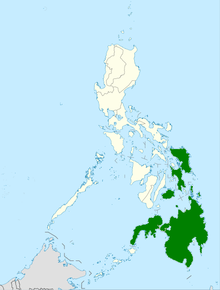Samar cobra
| Samar cobra | ||||||||||||
|---|---|---|---|---|---|---|---|---|---|---|---|---|

Head of a samar cobra ( Naja samarensis ) |
||||||||||||
| Systematics | ||||||||||||
|
||||||||||||
| Scientific name | ||||||||||||
| Well samarensis | ||||||||||||
| Peters , 1861 |
The Samar cobra ( Naja samarensis ) is endemic to the Philippines occurring spitting cobra , which the genus of genuine cobras belongs. The species name refers to the island of Samar , where the specimen that was used for the first description comes from.
description
The samar cobra usually reaches a length of up to four feet. The color of the snakes varies from dark brown to dark gray to black. The bottom of the head and neck are yellow in color. The neck is bordered by striking yellow to orange-yellow stripes. Like most cobras, it can spread its neck to form a pronotum. The longitudinal rows of scales are 21 to 23 around the neck, 19 in the middle of the body and 13 in the tail area. The number of ventralia (abdominal scales) is between 162 and 178 and that of the subcaudalia between 42 and 50.
The Samar cobra is unmistakable due to the characteristic markings on the neck.
toxicity
As a defense against enemies, the samar cobra spits a targeted jet of poison in the direction of the enemy's eyes. If the poison gets into a person's eyes, it causes severe pain and sometimes damage to the eyeball. If the eyes are not rinsed out properly, this can, in the worst case, lead to blindness. With regard to possible antidotes after being bitten by the Samar cobra, only a few results are available. In a study in 2020, examinations were carried out with the poisons in the Philippine cobra ( Naja philippinensis ) and the Samar cobra. It turned out that the Purified Cobra Antivenome (PCAV), as the only available antivenome at the time , was only moderately effective.
way of life
The Samar cobra is ground dwelling, crepuscular and nocturnal and likes to hunt on areas rich in vegetation. Their diet primarily includes frogs, small mammals and reptiles, and occasionally other snakes or birds. The respective prey is stunned or killed by a bite with a poison injection and then devoured whole. The species reproduces through oviparia (laying eggs). The predators include the Philippines eagle ( Pithecophaga jefferyi ).
distribution and habitat
The samar cobra is endemic to the southern Philippine archipelago of Visayas and Mindanao . Because of its occurrence, it is sometimes referred to in English as the Southern Philippine Cobra , Visayan Cobra or Samar Cobra . The name Peters' Cobra , which refers to the first descriptor Wilhelm Peters, is also in use. The snake predominantly inhabits moderately humid forests and bushy meadows, but also spreads in cultivated landscapes, as there is often a more varied range of food available.
Danger
Despite the limited habitat on some Philippine islands, the Samar Cobra is classified as " Least Concern " by the World Conservation Organization IUCN . However, the species is regionally endangered by persecution and even catch premiums. Sometimes it is also collected with food or as traditional medicine. Some cobras are exported to China, presumably also for use in traditional Chinese medicine .
Systematics
The species was first described in 1861 by the German naturalist Wilhelm Peters as Naja tripudians var. Samarensis .
Individual evidence
- ↑ a b Naja samarensis In: The Reptile Database ; accessed on November 27, 2021.
- ↑ Choo Hock Tan, Praneetha Palasuberniam, Francis Bonn Blanco, Kae Yi Tan: Immunoreactivity and neutralization capacity of Philippine cobra antivenom against Naja philippinensis and Naja samarensis venoms , Transactions of The Royal Society of Tropical Medicine and Hygiene, Volume 115, Issue 1, January 2021, pp. 78-84
- ^ Purified Cobra Antivenome
- ↑ Well samarensis in the endangered Red List species the IUCN 2009. Posted by: Sy, E., Custodio, C. Gonzalez, JC & Delima, EM, 2007. Accessed November 27 2021st
- ↑ Wilhem CH Peters , 1861: A second overview (compare monthly reports 1859 p. 269) of the collected by Mr. F. Jagor on Malacca, Java, Borneo and the Philippines and the Kgl. zoological museum sent snakes. Monthly royal Akad. Wiss. Berlin. 1861 (July): 683–691 [1862 on title page] ( online )
literature
- Wilhelm Carl Hartwig Peters: A second overview (compare monthly reports 1859 p. 269) of the collected by Mr. F. Jagor on Malacca, Java, Borneo and the Philippines and the Kgl. zoological museum sent snakes , monthly reports of the Royal Prussian Academy of Sciences in Berlin, 1861, p. 690 ( BHL )
- Wolfgang Bücherl, Eleanor E. Buckley, Venancio Deulofeu: Venomous Animals and Their Venoms: Venomous Vertebrates , Academic Press Inc., New York, 1968, p. 549
Web links
- southern-philippine-cobra - Ecology Asia, Southern Philippine Cobra
- animaldiversity.org - Animal Diversity Web
